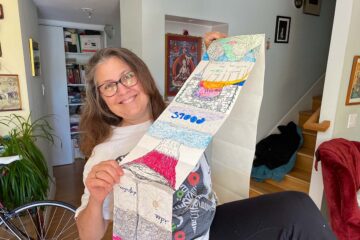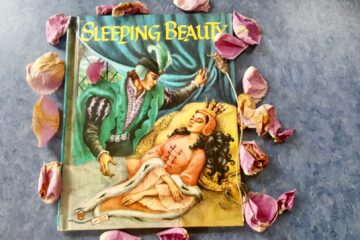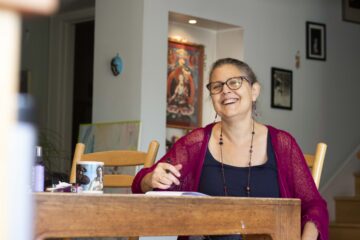“Neither a garden nor a park, but a city of the dead.” – Olmstead
Three times a year, before the pandemic, I visited Larry’s gravesite at Mountain View Cemetery— his birthday, the anniversary of his death, and Yom Kippur. On Saturday, April 24, 2021, Larry would have turned 68. He died when he was 47 and I was 39. Now I am 60 and he has been dead for over twenty years. The numbers add up and don’t. I am older than he ever was and the graveyard is closed. Last year when I drove down Moraga Avenue, turned right at the Chevron with the really good car wash, and up the road to the gates, the gates were locked. I considered heading home but decided to sit on the cement bench outside the graveyard to write my yearly missive.
“Dear Larry,” they all start, and I elaborate on recent changes, remarkable moments, things I still wish I could tell him in person. How amazing our son is as he transforms into his adult self across the country from me, and from this graveyard where he learned to ride his bike, skateboard, drive. He is far from the sloping hillside where each year I sat to write throughout his childhood while he fought invisible fiends with make-believe swords, then crouched beside me to give Larry his love across the veil to which we both grew accustomed.
And yet, although there is always more I want to tell the Larry I have imagined, or created, in these years of life after death, I never wanted his death to define my life. I wanted to move on and into my own singular vision of my artist self. He was my teacher from the time we met, and the difficult lessons did not stop when he died. I will always be grateful that he saw me from the first time I showed up in his Tai Chi class in my too short yellow nylon shorts, discombobulated by medical school in Mexico, by back pain, by loneliness and longing— that he recognized the way I competed with my idea of myself, and understood my distractibility, impatience, the way I held my breath.
I absolutely thank him for all he taught me over our 14 years together. From the slow, graceful Yang Style Tai Chi form, to the steady way he practiced bassoon measure by measure in order to perfect his attack, intonation, fluidity. His willingness to work through our rage-filled fights, my unprocessed fears, the complexities of physical and emotional pain. I also apologize. I’m sorry for my callous reactivity in the face of his failing body, for my resistance to criticism even when it was meant as support, and for all of the misguided rage expressed in desperation when I had no other way to say goodbye.
Then, I describe the hollow aspects of being in the world without his guidance, the echo of his music, and the whimsical humor with which he approached even the most challenging days of living and dying all at once. As I write it all into notebooks, beside his gravestone, I describe the lessons I continue to learn. The ways in which his death has allowed me to confront my fears, garner my strength, and appreciate the life I have created in these many years since he departed. This depth of self-exploration is enhanced by the elusive boundaries death offers. I find my way through various art forms without relying on death, but with death as a parameter, the timeline on which we all teeter, not as a threat, but a reflection of the constant gift of being alive to express my vision.
I also share what I have gained, how it feels to grow into my artist self. The effort to internalize his love has been a consistent challenge. Learning to recognize my distractions and bring myself back from tangential meanderings to the intentional ideas in my work takes patience and trust without explosive rage or silent withdrawal. Sometimes it means using new materials, like paper-making or inks, to explore and express feelings and visions I cannot yet convey with words. Last summer, after a battle with Covid, I blended into a pulp saved scrap
tissue paper, my grandmother’s frayed silk lampshade, and old tea leaves, then poured them onto a screen door and let it dry in the shape of a large tree I’d drawn on the screen beforehand. The visceral process of paper-making was freeing for me as I reentered myself despite the shelter-in place oddity of the world.
Sometimes returning to myself means sitting still in the garden and listening carefully to the birds call back and forth. The internalized ability to slow down, as he taught through Tai Chi, and to reconnect with breath when my mind trails off, has allowed me to follow my thoughts through to their emergence, and to more fully embody all of the creative energy I encounter as I make my way through each day. The patience to accept myself just as I am, even in a frustrated grouchy mood when my email won’t cooperate, came after loss. It came as I processed over and over the transformation of coping and grief into thriving and sorrow. The strength it took to move forward into the vast unknown alone with a young child was impossible to fathom before Larry died, but I knew that whatever I did, and however I coped, my beautiful young son would be watching, and so I learned to feel my strength and intelligence concurrently with sadness and vulnerability. Whether choreographing a dance about the birth of a star, or learning how to access my low abdominal muscles in a workout zoom, I can imagine Larry’s graceful cloud hands wafting across his line of vision, the esoteric teachings of moving meditation, and then return to my own conceptualization and follow through.
Loss has shaped the way I approach my work on multiple levels. The understanding that now and now and now have already passed by makes me conscious of the constraint imposed by time. While patience is a vital quality for self-expression, action is also imperative. Therein lies the challenge of balance. In Tai Chi, moving from one foot slowly onto the other, noticing the shift of weight like pouring water from one glass into another and not unbalancing the scales on which the glasses perch, was a constant refrain.
This dance between patience and urgency is also constant. Allowing myself time to descend into the flow of creativity, and also leaving enough space at the other side of the painting, dance, or essay writing to emerge whole has proven laborious. Sometimes I find that ringing a bell or a Tibetan bowl can help me with the shift, sometimes I need to scroll through social media in order to transition, and sometimes it helps to water the plants along the sides of the driveway. It is as if I must remember that there is an internal commute time necessary to get from the internal process self to the external relational self, and if I skip that transition, my behavior is unpredictable. This knowledge has taken years to acquire, and the more consistently I practice self-respect in this way, the more alive I am able to be in each moment. The death of loved ones has deepened my appreciation of life.
There are always the unanswerable questions of where loved ones reside when they are no longer on “the earth plane,” as Larry would say. I choose to believe that they are inside. Sometimes in objects — Larry’s swords, Patricia’s plants, the lace doily Susy and I got on our trip to Hungary in 1981— and sometimes in a passing memory or photograph. They seem to arise, if I allow myself to let them in (and learn to keep them from interrupting), with advice, support, or a smile. Doing side-kicks at the gym, Larry’s likeness appeared in my mind, kicking back at me in a playful routine and encouraging me to work out while working from within.
As I have grown comfortable with my grief, and the way this loss revealed my strength, I have also become more flexible, less bound by expectations. Sometimes the dead arise through odd coincidences, like when a wish comes true or a call comes through just as I think of someone. The trick, it seems, is to take the messages lightly. If I adhere too strongly to the wish for meaning, I can get lost in a projected dream of some unified theory. This flexibility serves my creative endeavors both in the exploratory phase and in my response to criticism. By learning to trust myself, I have also become more able to recognize teachers who show up to shed light. When I appreciate the coincidences I encounter and chalk them up as guideposts along my path, or perhaps friendly messages from an incomprehensible universe, I can enjoy the randomness of a complex life and the satisfaction of successfully expressing what I have learned along the way.



1 Comment
Caroline Day · May 8, 2021 at 11:13 pm
Barbara Joan, This is truly a remarkable essay. There are so many things to comment on. I love the way you fluidly tie in Larry’s teachings to your own ongoing process of self-discovery that manifests in contemplative creative expression. Larry’s presence alights like a butterfly and lifts you just as you might unnecessarily (from a reader’s standpoint) circle around your thoughts. In this way, the piece continues to dance engrossing the reader with revelations admirably void of cliches. Your writing has a lightness as if you are able to stand outside yourself with confidence that you have moved on from the darkness of loss(es) while still being able to tap into that layer of yourself that is part of the sedentary rock of an undoubtedly growing BJTB. 💜
I would like to see you include an image of your tree in your gallery. Seeing your art scaled to fit the page would reveal your layers.